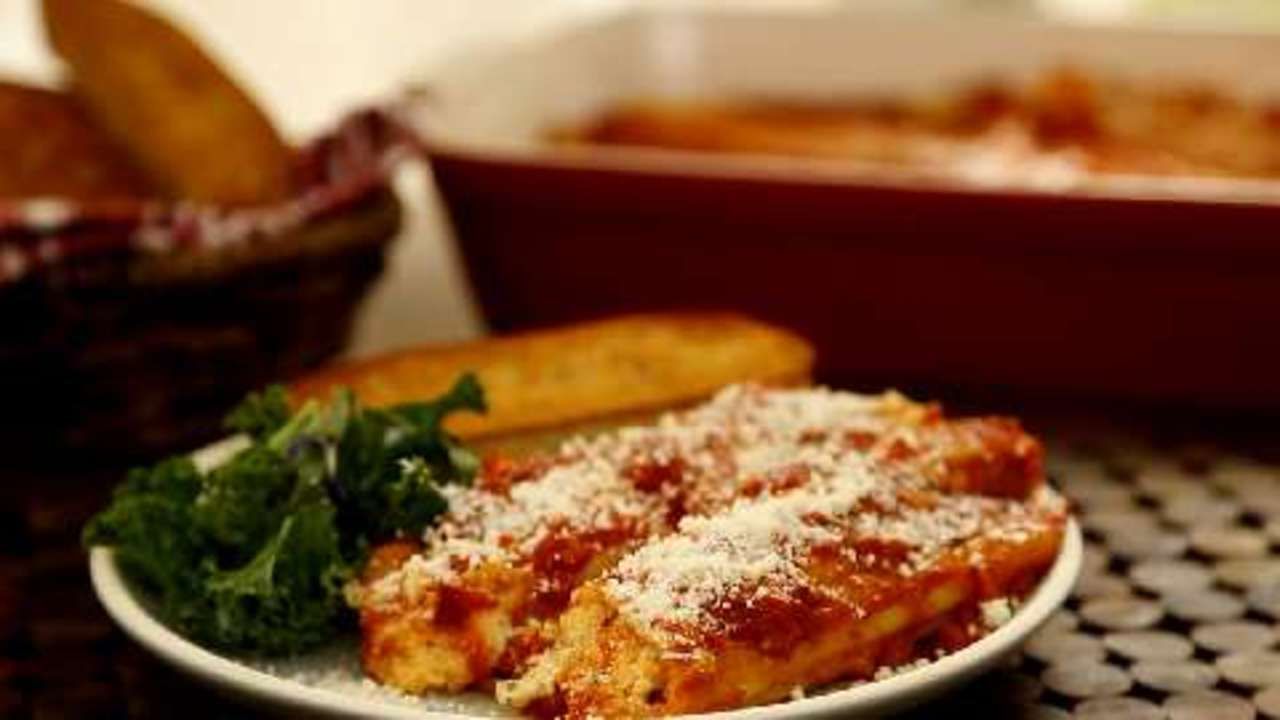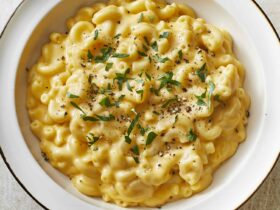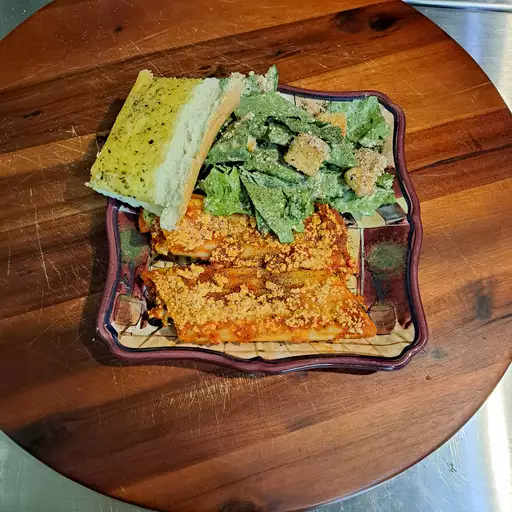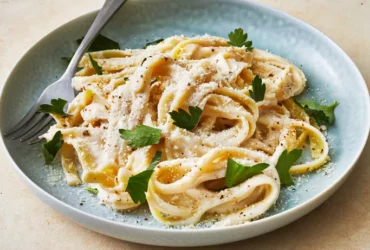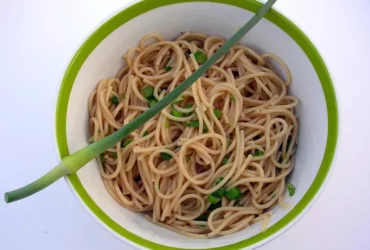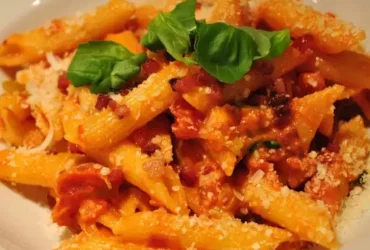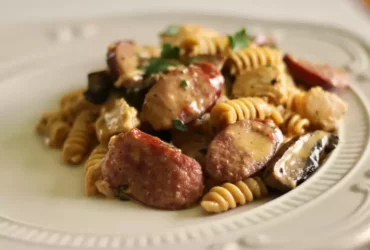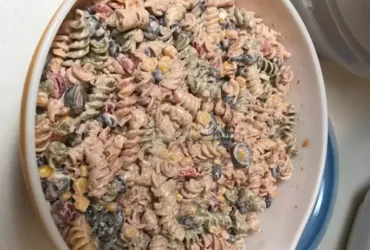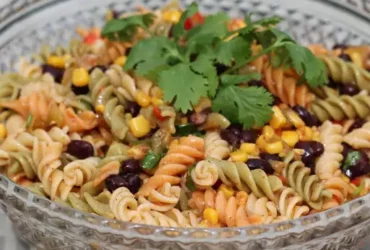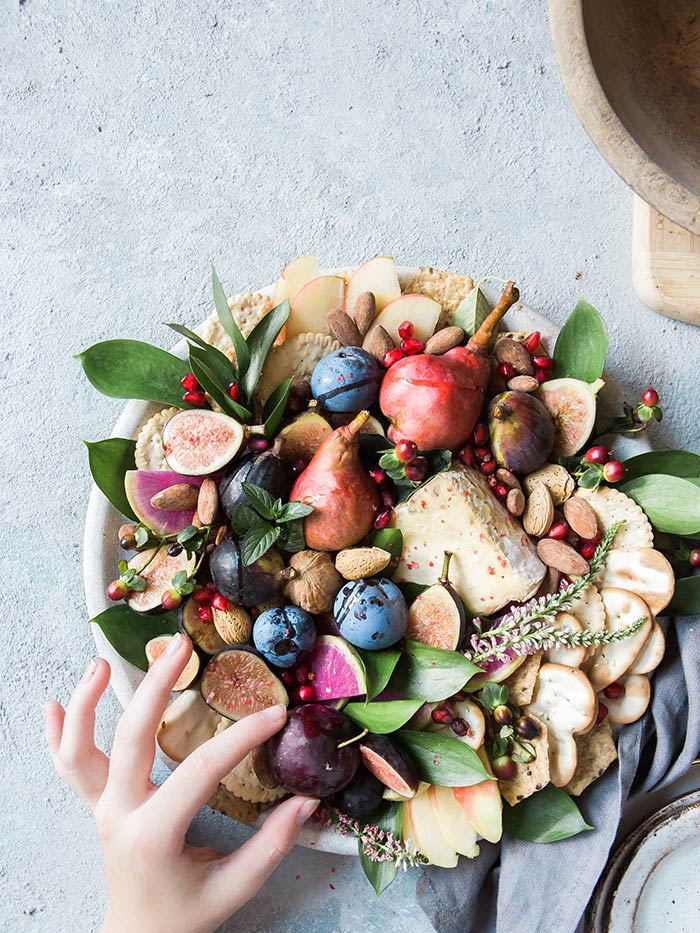Ingredients
Necessary Components
The preparation of manicotti requires an assortment of essential ingredients to achieve its signature flavor and texture.
To begin with, you will need a package of jumbo pasta shells or manicotti tubes.
These cylindrical pasta shapes are designed specifically for this type of dish, allowing the filling to be easily encased within their hollow centers.
For the ricotta cheese mixture, you’ll require 16 ounces of ricotta cheese, which serves as the primary binder and flavor component for the dish.
You may substitute the ricotta with a combination of cottage cheese or quark cheese if you prefer.
In addition to the ricotta cheese, you will need one large egg, salted and beaten until smooth, to add moisture and richness.
The egg mixture is then combined with one tablespoon of chopped fresh parsley for added flavor and visual appeal.
One teaspoon of dried basil adds a subtle herbal note that complements the Italian-inspired flavors present in manicotti.
A pinch of salt brings out the other seasonings and balances the dish’s overall taste profile, while 1/4 cup of grated Parmesan cheese provides an intense umami flavor.
For added moisture and creaminess to the filling, you can include one tablespoon of olive oil or melted butter, depending on your preference for a lighter or richer sauce.
The meat component in traditional manicotti is ground beef or pork, which are cooked until browned before being incorporated into the ricotta mixture.
This adds depth and texture to the filling as well as flavor. If you prefer a vegetarian option, omit this step entirely.
To complete the dish, you will need marinara sauce – preferably homemade but store-bought brands work too – for serving on top of the manicotti once baked.
1 pound jumbo pasta shells
To make this delicious Manicotti Recipe, you’ll need to start with the right ingredients. Here are the essential items on our shopping list:
- 1 pound jumbo pasta shells
- Ricotta cheese: We’ll be using a combination of whole-milk and low-fat ricotta to create a creamy yet lighter filling.
- Eggs: Two large eggs will provide structure and moisture to our cheese mixture.
- Parmesan cheese: A sprinkle of grated Parmesan adds salty depth and umami flavor to the dish. We recommend using high-quality, aged Parmesan for the best results.
- Mozzarella cheese: Shredded mozzarella will be melted on top of our manicotti for an irresistible golden-brown crust.
- Marinara sauce: A good-quality store-bought or homemade marinara sauce will serve as the base for our tomato-based sauce.
- Tomato paste: Concentrated tomato paste adds intense flavor and richness to our sauce. Look for a high-quality, salt-free option for best results.
- Olive oil: For cooking and adding moisture to our sauce.
- Garlic and onion powder: To add subtle depth and savory flavor to the sauce.
- Fresh parsley or basil: Chopped fresh herbs add color, texture, and freshness to the dish. Choose one or a combination of both for added complexity.
The quality of these ingredients will directly impact the final taste and appearance of our manicotti. Fresh ricotta cheese and high-quality Parmesan will result in a light yet creamy filling. Good-quality marinara sauce, tomato paste, and olive oil will add depth and richness to our sauce. Using fresh herbs like parsley or basil adds a pop of color and freshness to the dish.
Remember, the key to making great Manicotti is using high-quality ingredients that work together in harmony. Experiment with different cheese combinations, herb options, and cooking methods to find your perfect manicotti recipe.
4 tablespoons olive oil
The first ingredient to consider when making manicotti is olive oil, which serves as a base for sautéing and adding flavor to the dish.
In this recipe, 4 tablespoons of olive oil are used to cook the ingredients and add moisture to the manicotti tubes.
Here’s a breakdown of what you can expect from this ingredient:
- Pouring into the pan
- Sautéing with garlic, onions, and herbs
- Adding to the ricotta cheese mixture
Olive oil is a crucial ingredient in this recipe as it:
- Adds moisture and tenderness to the manicotti tubes
- Enhances the flavor of the dish with its distinct taste
- Helps to prevent the pasta from sticking together during cooking
It’s essential to note that using high-quality olive oil will make a significant difference in the overall flavor and texture of your manicotti.
In addition, you can also consider using other types of oils such as avocado oil or grapeseed oil for a different flavor profile.
However, it’s recommended to stick with traditional olive oil for its distinct taste and nutritional benefits.
1 onion, finely chopped
The ingredients required for an authentic manicotti recipe are as follows:
Main Ingredients:
- 1 onion, finely chopped
- 4 garlic cloves, minced
- 2 cups of ricotta cheese
- 1 cup of grated Parmesan cheese
- 1 egg
- Salt and pepper to taste
Main Course Pasta:
- 12-14 manicotti pasta tubes
Meat Sauce:
- 1 pound ground beef or ground turkey
- 2 tablespoons of olive oil
- 2 cups of marinara sauce
Garnishes:
- Grated Parmesan cheese for serving
- Fresh parsley for garnish
3 cloves garlic, minced
The ingredients required for this manicotti recipe include a variety of essential components that work together to create a delicious and satisfying dish.
- First and foremost, we have garlic – a fundamental ingredient in many Italian recipes.
- For this particular recipe, 3 cloves of garlic are minced to release their full flavor potential.
- The process of mincing involves finely chopping the garlic into small pieces to distribute its flavor evenly throughout the dish.
- This precise measurement of 3 cloves ensures that the flavor of the garlic is balanced and not overpowering, allowing the other ingredients to take center stage in the manicotti recipe.
1 pound ground beef
The first ingredient we’ll be discussing is 1 pound ground beef. This is a fundamental component in our Manicotti recipe, and it’s essential to understand what makes it so crucial.
The ground beef you choose should be of high quality, with an optimal fat content that will help keep the meat moist during cooking. Look for beef with around 20-25% fat content, as this will provide the right balance of flavor and texture.
When selecting your ground beef, consider the type of grind it has been given. You can usually choose between coarse (or chuck), fine, or extra-fine grinds. For Manicotti, we recommend using a medium grind, which will hold its shape during cooking without becoming too dense or hard.
Some other factors to consider when selecting your ground beef are the breed of cattle and any additives that may have been included in the production process. Look for beef from grass-fed cows, as this tends to be leaner and richer in nutrients. Also, avoid ground beef with added preservatives or fillers, which can negatively impact the flavor and texture of your dish.
To prepare our 1 pound ground beef, simply brown it in a pan over medium heat until it is fully cooked through. Use a wooden spoon or spatula to break up any large clumps as you go, working towards a uniform consistency throughout.
1 cup grated Parmesan cheese
The ingredients used for this Manicotti recipe are as follows:
Cheese Filling:
- 1 cup grated Parmesan cheese
- 8 ounces ricotta cheese
- 2 large eggs, lightly beaten
- 1 teaspoon salt
- 1/4 cup chopped fresh parsley
This list provides all the necessary ingredients to make the Manicotti. The Parmesan cheese is a crucial component in this recipe as it adds flavor and texture to the filling.
The Parmesan cheese used in this recipe should be freshly grated, as pre-grated cheese may contain additives that can affect the final taste of the dish. It’s also essential to choose high-quality Parmesan cheese that has a rich and nutty flavor to complement the other ingredients.
Optional Ingredients
The ingredients required for making manicotti are quite straightforward and include a few staple items that can be found in most kitchens. For the pasta, you will need to use 12-16 manicotti shells, which can be found in the Italian section of most grocery stores or online.
For the filling, you will need one pound of ricotta cheese, which is a type of soft and creamy cheese that originates from Italy. Ricotta is an excellent source of protein and can be used as a base for many different sauces and dips.
In addition to the ricotta cheese, you will also need to add some seasonings to give the filling flavor. These include one teaspoon of dried oregano, which is a popular herb that adds a savory flavor to many Italian dishes, and salt and pepper to taste.
It’s worth noting that while the above ingredients are the minimum required for making manicotti, you can also add some optional ingredients to give your dish extra flavor and texture. Some good options include one cup of grated Parmesan cheese, which is a hard aged Italian cheese that adds a salty flavor, and one cup of chopped spinach or other leafy greens, which can add a burst of freshness.
Other optional ingredients you might consider adding to your manicotti filling include one cup of sliced mushrooms or bell peppers, which can add some extra texture and flavor. You could also use other types of cheese, such as mozzarella or provolone, in place of the ricotta or in addition to it.
It’s worth noting that while the above ingredients are all delicious and can add a lot of flavor to your manicotti, they’re not essential and you can make a great dish without them. The most important thing is to use high-quality ingredients, such as fresh herbs and real cheese, to give your manicotti the best flavor possible.
8 ounces ricotta cheese
Ricotta cheese is a fundamental ingredient in many Italian dishes, and when it comes to manicotti recipe, 8 ounces of ricotta cheese are typically required.
Here’s what you need to know about the ingredients:
Origin
Ricotta cheese originates from Italy, where it’s been produced for centuries using sheep’s or cow’s milk. The traditional Italian way of making ricotta involves heating the whey leftover from cheese production and then straining it to create a creamy cheese.
Taste and texture
Ricotta cheese has a mild, creamy flavor and a soft, airy texture that makes it perfect for stuffing pasta shells like manicotti. It’s also versatile and can be mixed with various ingredients to change its taste and consistency.
Nutritional value
A serving of 8 ounces (225g) of ricotta cheese contains about 240 calories, 20 grams of fat, 16 grams of protein, and 1 gram of sugar. It’s also an excellent source of calcium and phosphorus.
Substitutions
While it’s possible to substitute ricotta with other cheeses like mascarpone or cottage cheese in a pinch, keep in mind that they have different textures and flavors, which may alter the overall taste and consistency of your manicotti filling. If you want to get close to the original Italian taste, stick with ricotta.
Salt and pepper to taste
The key to a truly exceptional Manicotti Recipe lies in the quality and balance of its ingredients.
Salt and pepper, although seemingly simple seasonings, play a crucial role in elevating the dish’s flavors.
Salt serves as a primary flavor enhancer, amplifying the other ingredients’ natural tastes while adding depth to the overall profile.
When using salt to taste, it’s essential to consider the type of salt used and its coarseness or fineness, as these factors can affect the final seasoning.
Pepper, on the other hand, adds a subtle yet distinct heat, providing a welcome contrast to the richness of other ingredients like cheese and meat.
The ratio between salt and pepper is crucial; too little may result in under-seasoning, while an overabundance can lead to an unpleasant, overpowering flavor.
As a general guideline, a good starting point for seasoning with salt and pepper is to add 1/4 teaspoon of each per serving or batch, adjusting to taste as needed.
It’s worth noting that the type and coarseness of salt used can impact this ratio. For example, finely ground salts may require less application than coarser varieties due to their more intense flavor release.
A well-balanced blend of flavors in Manicotti Recipe relies on understanding how these seemingly simple seasonings contribute to its overall character.
Fresh parsley for garnish
The choice of ingredients is crucial when it comes to preparing Manicotti, a classic Italian dish. Fresh herbs play a significant role in adding flavor and aroma to the pasta, and fresh parsley is no exception. When selecting fresh parsley for garnish, look for leaves that are vibrant green in color, have a crisp texture, and a fresh fragrance.
The ideal time to purchase fresh parsley is when it’s at its peak freshness, which is usually between spring and early summer months. Choose bunches with the most compact and tightly packed stems as they tend to be more flavorful than those that are loose or wilted.
When handling fresh parsley, avoid bruising the leaves or stems as this can cause them to become discolored or develop a bitter taste. Instead, gently wash the parsley under cold running water to remove any dirt or debris that may be present.
To prepare the fresh parsley for garnish, trim off the ends of the stems and chop the leaves into smaller pieces. You can also use kitchen shears to cut the parsley leaves into fine strips, which is ideal for adding a pop of color to the Manicotti dish.
Before using the chopped or chopped-and-striped fresh parsley as garnish, make sure it’s completely dry. Excess moisture can cause the parsley to lose its flavor and aroma quickly. You can gently pat the parsley with paper towels or a clean kitchen cloth to remove any excess moisture.
The amount of fresh parsley needed for garnish will depend on personal preference and the serving size of the Manicotti dish. Generally, a small handful of chopped or chopped-and-striped parsley is sufficient to add a pop of color and freshness to each serving.
Instructions
Preliminary Steps
Instructions for making Manicotti Recipe require attention to detail and adherence to a step-by-step process to ensure successful preparation.
Preliminary Steps are essential in preparing the ingredients needed for the recipe, including:
- Boiling water in a large pot for pasta
- Mixing ricotta cheese with parmesan, egg, salt, and pepper in a bowl
- Preparing the tomato sauce by sautéing garlic and onion in olive oil, then adding canned tomatoes and herbs
- Cooking lasagna noodles according to package instructions
Additionally, it is crucial to:
- Precut the lasagna noodles into manicotti shape
- Prepare a baking dish by brushing with olive oil and sprinkling with breadcrumbs
- Cooking the manicotti in boiling water for 3-5 minutes, or until al dente
- Serving the finished product hot, garnished with parmesan cheese and fresh basil
By following these preliminary steps and adhering to the instructions provided, individuals can successfully prepare a delicious Manicotti Recipe.
Preheat the oven to 375°F (190°C).
The first step in preparing delicious manicotti involves a crucial element that sets the stage for a perfect dish – preheating the oven to the ideal temperature. In this case, we need to set the thermostat to 375 degrees Fahrenheit or 190 degrees Celsius.
Why is it essential to be precise about the temperature? Preheating the oven to the correct temperature helps ensure that the ingredients cook evenly and at a consistent rate. This prevents overcooking or undercooking of the pasta, cheese, or other fillings, which can affect the overall flavor and texture of the manicotti.
When preheating the oven to 375°F (190°C), it’s also crucial to consider the type of oven you’re using. For instance, if your oven has a convection setting, you might need to adjust the temperature slightly or use a different cooking time to achieve the desired results.
The optimal temperature for baking manicotti helps preserve its shape and prevents it from becoming too crispy on the outside while remaining soggy inside. By preheating the oven to 375°F (190°C), you create an environment where the pasta cooks gently, absorbing flavors and textures evenly throughout.
Remember, precise temperature control is crucial in achieving a perfect manicotti dish. This attention to detail makes all the difference between a mediocre meal and a truly satisfying culinary experience.
Cook the pasta shells al dente according to package instructions.
To cook the perfect manicotti, it’s essential to follow the correct steps when preparing the pasta shells. Here are some instructions to achieve perfectly cooked pasta shells:
Step 1: Cooking the Pasta Shells
- Cook the pasta shells al dente according to package instructions.
- This means cooking them for a shorter time than recommended, so they retain some firmness in the center. This is crucial for preventing the pasta from becoming mushy or overcooked.
The ideal way to cook pasta shells al dente involves checking their texture by biting into one of the cooked shells. If it still has a bit of resistance, it’s ready to be used in the manicotti recipe.
Step 2: Preparing the Pasta Shells for Filling
- Once the pasta shells are cooked and cooled slightly, fill them with your favorite ricotta cheese mixture. You can use a store-bought or homemade version, whichever you prefer.
- Mound about 2-3 tablespoons of the ricotta filling onto each shell, leaving a small border around the edges to allow for even spreading.
Remember to handle the pasta shells gently when filling and arranging them in the baking dish to prevent breakage or damage.
Tips and Variations
- To enhance the flavor of your manicotti, try adding some chopped herbs like parsley, basil, or oregano to the ricotta cheese mixture. You can also use different types of cheese, such as mozzarella or Parmesan, for added depth.
- For a meat-based variation, add cooked ground beef, sausage, or bacon to the ricotta filling for an extra burst of flavor and texture.
By following these steps and experimenting with different fillings and flavors, you can create your own unique manicotti recipe that suits your taste preferences. Happy cooking!
In a skillet, heat olive oil over medium high heat.
To create a delicious manicotti recipe, it’s essential to follow accurate instructions. The first step involves heating olive oil in a skillet over medium-high heat. This requires attention to temperature control, as high heat can cause the oil to burn or smoke before it reaches its optimal temperature for cooking.
When working with a stovetop and oil, safety precautions are crucial. Ensure the area around the stove is clear of any combustible materials or objects that could catch fire in case of an accident. It’s also vital to stay alert while cooking, as high heat can lead to accidents if not monitored closely.
Once the olive oil reaches the correct temperature, it’s ready for cooking. The next step will be to sauté the ingredients called for in the recipe. This might include garlic, onions, or other aromatics that add depth and flavor to the dish.
As you proceed through each stage of the manicotti recipe, pay close attention to the instructions provided. Cooking involves a series of steps that must be performed in a specific order to achieve the best results. Deviating from these instructions could result in an inferior final product.
Remember, practice makes perfect when it comes to cooking. Following the same recipe multiple times will help you fine-tune your technique and develop a sense of how ingredients interact with each other at different stages of preparation.
In the context of a manicotti recipe, understanding the instructions is crucial for creating an authentic Italian dish that showcases its characteristic flavors and textures. By paying close attention to each step and following the guidelines provided, you’ll be well on your way to preparing a delicious meal that’s sure to satisfy your taste buds.
Nutrition and Variations
Dietary Considerations
Nutrition and variations are essential considerations when preparing a dish like manicotti, especially for individuals with specific dietary needs or preferences.
The traditional recipe for manicotti typically consists of jumbo pasta shells stuffed with a mixture of ricotta cheese, Parmesan cheese, and eggs, then baked in the oven with tomato sauce and melted mozzarella cheese.
However, this classic version may not be suitable for everyone due to its high calorie, fat, and sodium content. For example, those on a low-carb diet or suffering from gluten intolerance may need to modify their manicotti recipe accordingly.
To cater to these dietary considerations, several variations of the traditional manicotti recipe have been developed:
Low-Carb Manicotti
Use zucchini noodles (zoodles) instead of pasta shells and reduce the amount of ricotta cheese used in the filling.
Gluten-Free Manicotti
Replace traditional pasta shells with gluten-free alternatives, such as rice-based or corn-based options, and ensure that all ingredients, including sauces and seasonings, are gluten-free.
Vegan Manicotti
Substitute dairy products with plant-based alternatives like tofu, tempeh, or vegan cheese, and choose tomato sauce made from fresh tomatoes rather than canned.
Low-Sodium Manicotti
Use reduced-sodium cheese or make your own tomato sauce using low-sodium ingredients to minimize added salt.
In addition to these variations, consider the following nutritional considerations when preparing manicotti:
Protein Content
Ricotta cheese and eggs provide protein in the traditional filling, but you can also add cooked chicken or turkey to increase protein content.
Fat Content
Choose lower-fat cheese options, such as part-skim mozzarella, and use olive oil instead of butter for a healthier alternative.
Calorie Intake
Consider using smaller pasta shells or reducing the amount of filling used per shell to decrease calorie intake.
Freshness of Ingredients
Choose fresh, high-quality ingredients, such as whole tomatoes and fresh basil, to ensure optimal flavor and nutritional benefits.
According to the American Heart Association, incorporating moderate amounts of cheese into meals can support heart health when combined with balanced diets.
Nutrition and Variations play a crucial role in maintaining overall health, particularly when it comes to heart health.
The American Heart Association suggests that incorporating moderate amounts of cheese into meals can support heart health when combined with balanced diets.
This notion is especially relevant when considering the nutritional content of Manicotti, a classic Italian dish consisting of cylindrical pasta shells filled with meat sauce, ricotta cheese, and other ingredients.
A traditional Manicotti recipe often includes a generous amount of ricotta cheese, which can contribute to high calorie and fat intake when consumed in excess.
However, the American Heart Association’s guidelines emphasize the importance of moderation when it comes to cheese consumption, as part of a balanced diet that also includes plenty of fruits, vegetables, whole grains, and lean protein sources.
When preparing Manicotti, variations can be made to reduce fat content while maintaining flavor and nutritional value.
One option is to use lower-fat cheese alternatives or part-skim mozzarella instead of regular mozzarella for a slightly reduced calorie count.
Another approach is to increase the amount of vegetables in the filling, such as mushrooms, spinach, and bell peppers, which add fiber, vitamins, and antioxidants without significantly impacting fat content.
Furthermore, whole-grain pasta alternatives can be used instead of traditional all-purpose flour to increase the dietary fiber intake associated with each serving of Manicotti.
Incorporating these nutritional variations into a Manicotti recipe helps create a healthier, balanced dish that supports heart health and overall well-being.
Manicotti may also be adapted for vegetarian or vegan diets by substituting ricotta with plantbased alternatives.
- The versatility of manicotti allows for various adaptations to cater to different dietary needs and preferences.
- One common variation involves substituting traditional ricotta cheese with plant-based alternatives, making it suitable for vegetarian or vegan diets.
- This substitution can be achieved through the use of tofu, tempeh, seitan, or other meat-free options that mimic the texture and flavor of ricotta cheese.
- For vegetarians who consume dairy products, alternative cheeses such as soy-based ricotta or cashew-based cream cheese can be used to create a similar flavor profile.
- Vegans can opt for nut-based alternatives like almond milk ricotta or coconut-based cream cheese to add moisture and flavor to the manicotti filling.
In addition to dairy substitutions, other variations of manicotti may involve:
- Using whole wheat or whole grain pasta instead of traditional egg noodles to increase fiber content and nutritional value.
- Adding protein-rich ingredients like beans, lentils, or mushrooms to enhance the filling’s nutritional profile.
- Employing different herbs and spices to create unique flavor profiles, such as Italian-style with oregano and basil or Mexican-inspired with cumin and chili powder.
These variations not only cater to specific dietary needs but also offer opportunities for creativity and experimentation in the kitchen.
- Best Dun & Bradstreet (DNB) Alternatives for 2025 - April 24, 2025
- Best Seamless.ai Alternatives for 2025 - April 22, 2025
- Best Coldlytics Alternatives for 2025 - April 22, 2025

